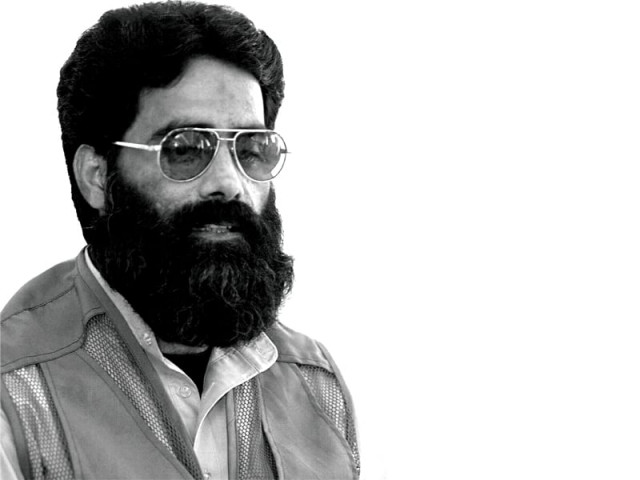Strike two: Ilyas Kashmiri dead – again
Headed the organisation blamed for PNS Mehran and GHQ attacks; group confirms death, vows revenge.

Strike two: Ilyas Kashmiri dead – again
In yet another major psychological blow to al Qaeda following the killing of Osama bin Laden, the network’s leader in Pakistan Ilyas Kashmiri has been killed in a US drone strike in South Waziristan.
Kashmiri, 47, was chief of the dreaded 313 Brigade of Harkatul Jihad al Islami (HJUI) militant group that has been described by US counter terrorism officials as an operational wing of al Qaeda. He was earlier incorrectly reported to have been killed in a September 2009 strike by a US drone.
Kashmiri, who had a maximum bounty of $5 million on his head, was killed in a missile strike by a CIA-operated pilot-less aircraft in the Karikot area of South Waziristan, intelligence officials and local sources said.
“The strike took place in the Karikot area on the outskirts of Wana, the main town in South Waziristan, before midnight on Friday,” local sources said. “Some ‘guests’ were sitting in an apple orchard when a loud explosion took place.”
An intelligence official in Peshawar endorsed this version.
“Kashmiri was having tea with his men in the orchard when the strike took place. All nine militants, all of them from Punjab, were killed in the attack,” he told The Express Tribune.
Another intelligence official and local political administration also confirmed Kashmiri’s death.
“We are sure that he (Kashmiri) has been killed. Now we are trying to retrieve the bodies. We want to get photographs of the bodies,” said the official.
Kashmiri and other militants were meeting an Afghan Taliban who worked in liaison with the Tehreek-i-Taliban Pakistan (TTP) when the drone missile struck, he added.
Though the TTP denied the reports saying Kashmiri was alive, his own group confirmed his death.
“We confirm that our Amir (leader) and commander-in-chief, Muhammad Ilyas Kashmiri, along with other companions, was martyred in an American drone strike on June 3, 2011, at 11:15 pm,” Abu Hanzla Kashir, who identified himself as an HUJI spokesperson, said in a statement faxed to media outlets.
“God willing ... America will very soon see our full revenge. Our only target is America,” the statement added. The authenticity of the statement could not be verified though.
According to US media, Kashmiri had moved to Wana from Khyber-Pakhtunkhwa 10 days ago.
“We were closing in on him and he switched off his satellite and cellular phone ... he wanted to cross the border into Afghanistan to find a hiding place,” an intelligence official told Reuters.
“It was a tipoff by us since we were closely monitoring his movements,” the official said, referring to the drone strike.
Kashmiri’s 313 Brigade is widely believed to have masterminded the May 22 brazen attack on Pakistan’s key naval airbase in Karachi in which 10 security personnel were killed and two surveillance planes worth millions of dollars were destroyed.
He has also been blamed for the October 2009 attack on the army headquarters, GHQ, in Rawalpindi.
Counterterrorism officials believe he was the main coordinator of a terror plot targeting Britain, France, Germany and the US, apparently in early stages when detected by intelligence agencies in 2010.
Kashmiri’s name was believed to be on a list, which the US gave Pakistan, of senior militants it wanted killed or captured.
Others on the list include Taliban leader Mullah Omar, Haqqani network chief Sirajuddin Haqqani and al Qaeda No 2 Ayman Al Zawahiri.
Brig (retd) Shaukat Qadir, former president of the Policy Research Institute in Islamabad told The Express Tribune that Pakistani intelligence officials had tipped off the CIA about Kashmiri’s presence in the orchard.
Drone strikes have increased under the administration of President Barack Obama. Though some key militants have been killed in drone attacks, but the number of civilians killed in such attacks is much higher, fuelling anti-American sentiment in Pakistan.
While Pakistani leaders publicly criticise drone strikes, analysts say killing high-value targets like Kashmiri would not be possible without Pakistani intelligence.
Harkatul Jihad al Islami (HuJI)
- The Harkatul Jihad al Islami (HuJI) is a militant organisation – of which Ilyas Kashmiri was the operational commander – with an affiliate in Bangladesh. Qari Saifullah Akhtar along with two of his associates, Maulana Irshad Ahmed and Maulana Abdus Samad Sial, all seminary students from Karachi, were instrumental in laying the foundation of Jamiat Ansarul Afghaneen in the 1980s.
- The HuJI persisted even after the Soviet withdrawal from Afghanistan in 1989, merging with another militant group known as the Harkatul Mujahideen, forming Harkatul Ansar which subsequently began operations in Kashmir.
- In 1997, it renamed itself again as Harkatul Mujahideen to avoid being termed a ‘Foreign Terrorist Organisation’ by the US.
Ilyas Kashmiri: 313 Brigade chief
- Ilyas Kashmiri was the operational commander of the militant organisation Harkatul Jihad al Islami (HuJI), who had a bounty of $5 million on his head.
- He reportedly escaped a US drone strike in North Waziristan in late 2009. He has been blamed for multiple attacks in Pakistan, including an attack on a naval base in Karachi and on the army headquarters in Rawalpindi.
- Counter-terrorism officials believe he was the main coordinator of a terror plot targeting Britain, France, Germany and the United States.
- In January 2010, a US federal grand jury indicted him for a plot to attack Danish newspaper Jyllands-Posten over blasphemous cartoons.
- Included on US and UN terror blacklists, Ilyas Kashmiri was born in 1964 in Azad Kashmir.
(With additional input from Iftikhar Firdaus in Peshawar and Reuters)
Published in The Express Tribune, June 5th, 2011.













COMMENTS
Comments are moderated and generally will be posted if they are on-topic and not abusive.
For more information, please see our Comments FAQ